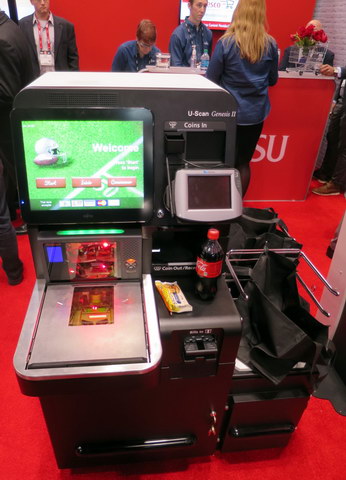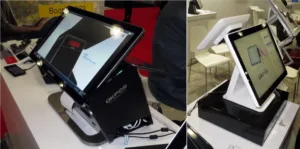Point-of-sale (POS) terminals have displaced cash registers in the technology-centric stores and chains that the NRF Big Show caters to. While traditional cash registers may still be in use in small, individually-owned stores, there was no trace of them at the Big Show.
A basic POS terminal includes a single touch display for the store clerk, a host computer and a cash box. Typically a bar code scanner, printer and a credit card reader are attached to the basic unit via USB or some other interface. If the store sells things by weight, a scale is added. A common additional option is a second touch or non-touch display for the customer. These can all be separate units or they can be integrated into a single unit by the POS vendor. The POS terminal is normally connected to the cloud for applications like inventory control. The credit card reader has a separate connection over the Internet to a credit card service company.
There were literally hundreds of vendors at the NRF show featuring POS terminals in their booths. I spent some time talking to the representative for Okpos, said to be the #1 supplier of POS terminals in Korea. Okpos is part of the Nice Group. The Nice Group was founded in 1986 as National Information & Credit Evaluation Inc. Okpos was founded in 1993 as a credit card-related information technology business and entered the POS business in 1995. The company has grown in sales from $26.6M in 2012 to $80.0M in 2016 and has sustained a CAGR of about 42% since 2009.
The company was showing multiple POS terminals, the two most recently introduced shown in the image. On the left is the W185, a modular unit intended for high-end applications and introduced in October 2016. The unit is shown with a 18.5” touchscreen display plus a smaller display for the customer. A smaller display for the clerk can be used, if desired. The host computer is built into the unit and is based on an Intel Core i3 processor and can be configured with 2 – 8 GB of memory. The computer has multiple interfaces, including 6 x RS-232, 6 x USB, 1 x PS/2 (!!) for keyboard and mouse, 1 Dual VGA and a 3W speaker. The unit on the right is a prototype of a POS terminal that is more fully integrated and intended for mainstream applications.
Okpos POS Terminals. L: W185 high-end product and prototype of a mainstream unit.
I also spoke to the Fujitsu representative about POS terminals intended for self-checkout applications, such as the one shown in the photo. This unit is equipped with cash recycling, a common feature in Europe, he told me, but not common in the US yet. In a normal self-service POS terminal equipped to handle cash, there are two internal slots for each denomination of bill and coin. One is the receiving slot for cash put in by the customer and the second is the dispensing slot to provide change to the customer. In a cash recycling POS terminal, there is only one slot for each denomination and it both accepts cash from the customer and dispenses change to the customer. This system requires a lower inventory of cash at the retail location, a desirable feature. While the Fujitsu representative said reliability is not a problem, he said US POS purchasers have been wary of cash recycling POS terminals because of their complex mechanical systems. He said it is typical for the cash in a self service POS terminal to be serviced once a day, with the customer input cash removed and the customer change cash replenished. He added that self service POS terminals do not need the complex armor used in bank ATMs because the terminals are always in areas that are closely watched by store employees.
 Fujitsu self-service POS terminal equipped with cash recycling
Fujitsu self-service POS terminal equipped with cash recycling

